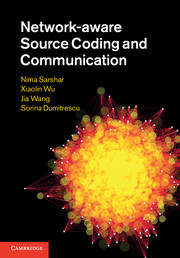Book contents
- Frontmatter
- Contents
- 1 Introduction
- Part I The lossless scenario
- Part II The lossy scenario
- 5 Lossy source communication: an approach based on multiple-description codes
- 6 Solving the rainbow network flow problem
- 7 Continuous rainbow network flow: rainbow network flow with unbounded delay
- 8 Practical methods for MDC design
- 9 Using progressive codes for lossy source communication
- 10 Lossy communication of multiple correlated sources
- References
- Index
8 - Practical methods for MDC design
from Part II - The lossy scenario
Published online by Cambridge University Press: 07 October 2011
- Frontmatter
- Contents
- 1 Introduction
- Part I The lossless scenario
- Part II The lossy scenario
- 5 Lossy source communication: an approach based on multiple-description codes
- 6 Solving the rainbow network flow problem
- 7 Continuous rainbow network flow: rainbow network flow with unbounded delay
- 8 Practical methods for MDC design
- 9 Using progressive codes for lossy source communication
- 10 Lossy communication of multiple correlated sources
- References
- Index
Summary
Multiple-description codes are powerful tools for network-aware source coding and communication, as suggested in the previous chapters. We showed how MDC can be useful even in error-free networks. MDC, however, traditionally has been used to combat losses in packet lossy networks in which packets are likely to be dropped or lost. In this chapter, we review practical techniques for construction and optimization of MDCs.
In the most general setting, an MDC scheme generating K descriptions can be regarded as a system consisting of K encoders (also called side encoders), and 2K - 1 decoders, one for each subset of descriptions. Figure 8.1 illustrates the block diagram of an MDC scheme for three descriptions. Each encoder generates a bit stream (description) of the same source and sends it to the receiver(s). The sender does not know how many streams are received by a particular receiver, but each receiver has this information. If only some descriptions arrive at a given destination, the decoder corresponding to that subset of descriptions is used to jointly decode them. The K decoders corresponding to individual descriptions are called side decoders, while the others are termed joint decoders. Moreover, the joint decoder corresponding to the whole set of descriptions is known as the central decoder.
Overview of MDC techniques
Practical MD coding schemes for memoryless sources have been extensively investigated. Some of the most representative approaches are PET-based MDC, MD quantization, and MD correlating transforms. This section offers a brief overview of these three approaches.
- Type
- Chapter
- Information
- Network-aware Source Coding and Communication , pp. 82 - 131Publisher: Cambridge University PressPrint publication year: 2011



